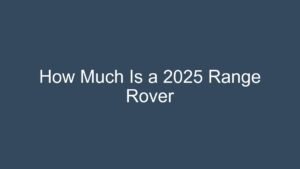
Contents
- Unleashing the Beast: How Much Does a Dodge SRT Hellcat Truly Cost?
- 🛒 Recommended Product
- The Allure of the Hellcat: More Than Just Horsepower
- Decoding the Sticker Price: New vs. Used SRT Hellcat Costs
- Beyond the Purchase: The True Cost of Hellcat Ownership
- 🛒 Recommended Product
- Step-by-Step Guide: Calculating Your Hellcat Budget
- Pro Tips for Buying Your SRT Hellcat
- Common Mistakes to Avoid When Buying a Hellcat
- Conclusion: Is the SRT Hellcat Worth the Investment?
- 🛒 Recommended Product
- FAQ
- Related Articles
Unleashing the Beast: How Much Does a Dodge SRT Hellcat Truly Cost?
The roar of a Dodge SRT Hellcat is unmistakable – a symphony of raw power, supercharged exhilaration, and pure American muscle. For many, owning one of these 700+ horsepower marvels is the ultimate automotive dream. But beyond the eye-catching design and heart-pounding acceleration, a common question echoes in the minds of aspiring owners: “How much does an SRT Hellcat truly cost?”
It’s a great question, and the answer is more nuanced than just a sticker price. While the initial purchase price is a significant factor, the total cost of SRT Hellcat ownership involves a thrilling ride through various expenses, both upfront and ongoing.
In this detailed, friendly guide, we’ll break down every aspect of the Hellcat’s price tag, helping you budget wisely and drive home your dream machine without unexpected financial bumps in the road.
🛒 Recommended Product
The Allure of the Hellcat: More Than Just Horsepower
Before diving into the numbers, let’s appreciate what you’re investing in. The Dodge Challenger and Charger SRT Hellcat models aren’t just cars; they’re an experience. With their supercharged 6.2L HEMI V8 engines, they deliver mind-blowing acceleration, aggressive styling, and a heritage rooted deep in muscle car culture. Whether you’re eyeing a Challenger Hellcat for its classic coupe lines or a Charger Hellcat for its four-door practicality with supercar performance, you’re looking at a vehicle that demands respect – and a well-thought-out budget.
Decoding the Sticker Price: New vs. Used SRT Hellcat Costs
The first major decision you’ll face is whether to buy a brand-new Hellcat or explore the robust used market. Both paths have their financial implications.
1. The Cost of a New SRT Hellcat (MSRP)
When buying new, you’re getting the latest features, the full factory warranty, and the thrill of being the first owner. The Manufacturer’s Suggested Retail Price (MSRP) for a new SRT Hellcat can vary significantly based on the model (Challenger or Charger), trim level, and optional packages.
- Standard SRT Hellcat: Expect the base MSRP for a new Challenger or Charger Hellcat to start roughly in the mid-$70,000 to low-$80,000 range. This is your entry point to the 700+ horsepower club.
- SRT Hellcat Redeye: For those who crave even more power (797 horsepower!), the Redeye variants naturally come with a higher price tag, often starting closer to the high-$80,000 to mid-$90,000 range.
- SRT Hellcat Jailbreak/Demon 170 (if available): Special editions or limited production models, like the Jailbreak options offering more customization or the ultra-rare Demon 170, will command significantly higher prices, sometimes reaching well over $100,000 or even into the low $200,000s for the most extreme versions.
Key Factors Affecting New Hellcat Price:
- Model Type: Challenger vs. Charger.
- Trim Level: Standard Hellcat, Hellcat Redeye, Jailbreak, etc.
- Optional Packages: Performance upgrades, aesthetic enhancements, technology packages, premium interiors. These can add several thousand dollars to the MSRP.
- Destination Charges: A non-negotiable fee charged by the manufacturer for transporting the vehicle to the dealership, typically around $1,500 to $2,000.
- Dealer Markups: Especially for high-demand or limited-edition models, some dealerships might add markups above MSRP. Always negotiate these.
2. The Cost of a Used SRT Hellcat
The used market often presents a more accessible entry point to Hellcat ownership, but prices can fluctuate wildly. Depreciation is a reality for any high-performance vehicle, making used models an attractive option.
- Typical Range: You can find used SRT Hellcats spanning a wide range, often from the mid-$40,000s for earlier models (2015-2018) to the high-$60,000s or even low-$70,000s for newer, low-mileage examples or Redeye variants.
- Factors Influencing Used Prices:
- Year of Manufacture: Newer models command higher prices.
- Mileage: Lower mileage generally means a higher price.
- Condition: Excellent condition (interior, exterior, mechanical) will fetch more.
- Trim Level: Redeye versions usually hold their value better than standard Hellcats.
- Modifications: Aftermarket modifications can either increase or decrease value depending on their quality and desirability.
- Accident History: Any reported accidents will significantly reduce the value.
- Location: Prices can vary based on regional demand.
Remember: While a lower initial purchase price is appealing, a used Hellcat might require more immediate maintenance or the replacement of wear items like tires or brakes sooner than a new one.
Beyond the Purchase: The True Cost of Hellcat Ownership
The sticker price is just the beginning. The ongoing costs of owning an SRT Hellcat are substantial and often underestimated. Ignoring these can turn your dream car into a financial nightmare.
1. Insurance Premiums
This is often the biggest hidden cost for Hellcat owners. Due to their high horsepower, performance capabilities, and unfortunate popularity among thieves, Hellcats are incredibly expensive to insure.
- Expect to pay significantly more than for a standard vehicle. Annual premiums can range from $3,000 to $7,000 or even higher, depending on several factors.
- Factors Affecting Insurance Costs:
- Driver’s Age and Experience: Younger, less experienced drivers will pay much more.
- Driving Record: Clean records get better rates.
- Location: Urban areas with higher theft rates often mean higher premiums.
- Coverage Levels: Full coverage (collision, comprehensive) is almost a necessity for such a valuable vehicle.
- Vehicle Security Features: Some insurers offer discounts for advanced anti-theft systems.
- Credit Score: Can influence rates in some states.
Critical Tip: Get multiple insurance quotes before you even start seriously looking at Hellcats. This will give you a realistic idea of a major ongoing expense.
2. Fuel Costs
The supercharged HEMI V8 is thirsty. Very thirsty.
- Premium Fuel Only: Hellcats require premium 91+ octane fuel. Do not cheap out on this, as it can damage the engine over time.
- Fuel Economy: Expect abysmal fuel economy, typically around 13-16 MPG combined (and much lower if you enjoy the throttle). If you drive frequently, your monthly fuel bill will be substantial.
- Budget accordingly: If you drive 12,000 miles a year, you could easily spend $3,000-$5,000+ annually on fuel alone, depending on gas prices.
3. Maintenance and Tires
High performance demands high-performance components, and those come at a cost.
🛒 Recommended Product
- Tires: This is another major recurring expense. Hellcats chew through tires quickly, especially if you enjoy spirited driving.
- High-performance summer tires are expensive, often costing $300-$500+ per tire.
- Expect to replace a full set of tires every 10,000-20,000 miles, or even sooner. Budget $1,500 – $3,000+ for a set, installed.
- Brakes: The Hellcat’s powerful Brembo braking system provides incredible stopping power, but replacement pads and rotors are expensive. Expect to pay $1,000 – $3,000+ per axle when they eventually need replacing, depending on the components.
- Routine Maintenance: While oil changes and basic service might not be vastly different from other cars, some specific parts or labor for performance vehicles can be pricier. Always follow the manufacturer’s recommended maintenance schedule.
4. Registration, Taxes, and Fees
Don’t forget the standard costs of vehicle ownership:
- Sales Tax: Varies by state, but can add thousands of dollars to the purchase price (e.g., 5-10% of the vehicle’s value).
- Registration Fees: Annual fees for license plates and registration, varying by state and vehicle value/weight.
- Documentation Fees: Dealership fees for processing paperwork, typically a few hundred dollars.
- Luxury Tax (if applicable): Some jurisdictions may have additional taxes for high-value vehicles.
5. Depreciation
While not an out-of-pocket cost in the same way, depreciation is the loss of your vehicle’s value over time. For new cars, it’s often the single largest “cost” of ownership. Even performance cars like the Hellcat depreciate, although some special editions may hold value better. Understanding depreciation helps you assess the true long-term financial impact.
Step-by-Step Guide: Calculating Your Hellcat Budget
Ready to make your dream a reality? Follow these steps to build a realistic financial plan.
Step 1: Determine Your Target Hellcat (New vs. Used, Trim Level)
* Research current market prices for the specific year and model you’re interested in. Use sites like Kelley Blue Book, Edmunds, and major online used car marketplaces.
Step 2: Calculate the Initial Purchase Price
* For New: Start with MSRP, add destination charges, optional packages, and estimated sales tax. Subtract any potential negotiation savings.
* For Used: Use the average market price for your desired year/mileage/condition, add estimated sales tax, and account for potential dealer doc fees.
Step 3: Factor in Financing (if applicable)
* Down Payment: How much cash can you put down? A larger down payment reduces your loan amount and interest paid.
* Loan Term: Shorter terms mean higher monthly payments but less interest. Longer terms mean lower payments but more interest over time.
* Interest Rate (APR): Get pre-approved by your bank or credit union to know your rate before visiting a dealership.
* Use an online car loan calculator to estimate your monthly car payment.
Step 4: Obtain Multiple Insurance Quotes (This is CRUCIAL!)
* Provide your exact details (age, driving record, location, desired coverage) for the specific Hellcat model you’re considering.
* Contact at least 3-5 different insurance providers to compare rates. This step could save you thousands annually.
Step 5: Estimate Ongoing Monthly/Annual Operating Costs
* Fuel: Based on your estimated mileage and current premium fuel prices.
* Tires: Assume one set every 1-2 years (roughly $100-$250 per month averaged out).
* Maintenance: Set aside a few hundred dollars per month ($50-$200+) for routine service and unexpected repairs.
* Registration/Taxes: Divide annual costs by 12 for a monthly figure.
Step 6: Sum It All Up for a “Total Cost of Ownership” Picture
* (Monthly Car Payment) + (Estimated Monthly Insurance) + (Estimated Monthly Fuel) + (Estimated Monthly Maintenance/Tire Fund) + (Monthly Portion of Annual Fees) = Your Total Estimated Monthly Hellcat Cost.
* Be honest and conservative with your estimates. It’s better to over-budget than under-budget.
Pro Tips for Buying Your SRT Hellcat
- Shop Around Aggressively: Don’t just settle for the first dealer you visit. Competition is fierce, and you can often find better deals on both new and used models.
- Get Pre-Approved for Financing: Knowing your interest rate and loan terms from your own bank gives you leverage at the dealership.
- Always Get a Pre-Purchase Inspection (PPI) for Used Hellcats: Spend a few hundred dollars to have an independent, trusted mechanic inspect the vehicle thoroughly. They can uncover hidden issues (e.g., engine problems, accident damage, worn components) that could save you thousands later.
- Negotiate Every Aspect: The car price, your trade-in value (if applicable), and even extended warranty prices are often negotiable.
- Understand Dealer Fees: Ask for a full breakdown of all fees before signing anything. Some fees are legitimate (e.g., state-mandated), while others might be negotiable or avoidable.
- Consider a Certified Pre-Owned (CPO) Hellcat: If available, a CPO program from Dodge can offer extended warranty coverage and a rigorous inspection process, providing more peace of mind for a used purchase.
- Budget for Winter Tires (if applicable): If you live in a cold climate, the Hellcat’s performance tires are not safe in freezing temperatures or snow. You’ll need a separate set of winter tires and wheels, another significant expense.
Common Mistakes to Avoid When Buying a Hellcat
- Underestimating Ongoing Costs: This is the #1 mistake. Many buyers focus solely on the car payment and forget about the high cost of insurance, fuel, and tires.
- Not Getting Insurance Quotes First: Assuming your current insurance will be “a little more” is a dangerous gamble. Get actual quotes.
- Skipping the PPI on a Used Hellcat: You’re buying a highly stressed, high-performance machine. Don’t buy blind. A clean CarFax is a good start, but it’s not a substitute for a mechanical inspection.
- Falling for the “Low Monthly Payment” Trap: Dealers might stretch a loan term to 7 or even 8 years to make payments seem affordable. This means paying much more in interest and being “upside down” (owing more than the car is worth) for a longer period.
- Ignoring Maintenance Schedules: Neglecting routine maintenance on a performance engine will lead to costly repairs down the line.
- Impulse Buying: The Hellcat’s allure is powerful, but a rushed decision can lead to financial regret. Take your time, do your research, and plan meticulously.
- Modifying Without Research: While tempting, aftermarket modifications can void warranties, reduce resale value (if not done professionally with quality parts), and even make your insurance more expensive. Research thoroughly.
Conclusion: Is the SRT Hellcat Worth the Investment?
For many, the answer is a resounding yes! The Dodge SRT Hellcat offers an unparalleled blend of brute force, iconic styling, and daily drivability (for a performance car). It’s an investment in an experience, a statement, and a piece of automotive history.
However, it’s an investment that comes with a significant price tag, not just upfront, but throughout its ownership. By taking a detailed, realistic approach to budgeting and understanding all the costs involved, you can avoid financial surprises and truly enjoy every supercharged mile.
🛒 Recommended Product
So, do your homework, prepare your budget, and get ready to unleash the beast responsibly. Your dream Hellcat awaits!
FAQ
Q. How much does a brand-new Dodge Challenger or Charger SRT Hellcat typically cost?
A. For a brand-new Dodge Challenger or Charger SRT Hellcat, the Manufacturer’s Suggested Retail Price (MSRP) usually starts in the low to mid-$70,000 range. This price can increase significantly with optional features, packages, and the specific trim level (like the Widebody option), pushing it into the $80,000s or even $90,000s before taxes and fees.
Q. What is the price range for a used SRT Hellcat?
A. The cost of a used SRT Hellcat varies widely based on its year, mileage, condition, trim level (e.g., standard Hellcat, Redeye, Jailbreak), and market demand. You can typically find used models ranging from the mid-$40,000s for older, higher-mileage examples, up to the $70,000s or even $80,000s for newer, low-mileage Redeye or special edition models.
Q. What factors influence the final price of an SRT Hellcat?
A. Several key factors impact the final price:
* Trim Level: Standard Hellcat, Hellcat Widebody, Redeye, Redeye Widebody, and Jailbreak editions each carry different price points.
* Optional Packages & Features: Add-ons like specialized paint, performance upgrades, interior packages, and technology packages will increase the price.
* New vs. Used: New models command MSRP or potentially higher due to market adjustments, while used prices depend on age, mileage, and condition.
* Dealer Markups: Especially for popular or limited models, some dealerships may add markups above MSRP.
* Market Demand: High demand can drive prices up, particularly for sought-after configurations.
Q. Are there different SRT Hellcat models that cost more than the standard version?
A. Yes, absolutely. The standard SRT Hellcat is the entry point. More powerful and specialized versions like the SRT Hellcat Redeye, with its higher horsepower, and the even more exclusive SRT Hellcat Jailbreak models, which offer extensive customization options, command a significantly higher price. These can easily add $10,000 to $20,000 or more to the base Hellcat price.
Q. Beyond the purchase price, what are the ongoing costs of owning an SRT Hellcat?
A. While the initial purchase is a major cost, ongoing expenses for an SRT Hellcat include:
* Insurance: High-performance vehicles like the Hellcat typically have much higher insurance premiums due to their power and replacement cost.
* Fuel: With its supercharged V8 engine, the Hellcat has a substantial appetite for premium fuel, leading to significant fuel costs, especially with spirited driving.
* Maintenance: Performance tires are expensive and wear quickly, and specialized maintenance for a high-performance engine can also be pricier than for a standard vehicle.
* Taxes and Registration: These will vary by location but are generally higher for more expensive vehicles.
Q. Do SRT Hellcats hold their value well over time?
A. SRT Hellcats generally hold their value quite well compared to many other performance cars, especially for desirable special editions or low-mileage examples. Their powerful engines, iconic status, and limited production (particularly for certain variants) contribute to strong resale values. However, like any vehicle, depreciation does occur, with the steepest drops typically in the first few years. Well-maintained, unmodified examples tend to fare best in the used market.
Related Articles
How Much Is a Corvette
How Much Does a Corvette Cost? Your Ultimate Guide to Unlocking the Dream Ah, the Corvette. Just uttering the name conjures images of sleek lines, exh…
How Much Is a Grand Wagoneer
How Much Is a Grand Wagoneer? Your Complete Guide to Understanding the Price Tag The Grand Wagoneer. Just the name conjures images of luxurious comfor…
How Much Is a Mclaren 720s
How Much Is a McLaren 720S? Your Ultimate Guide to Understanding the Price Tag The McLaren 720S. Just the name conjures images of blistering speed, ae…
Affiliate Disclosure: As an Amazon Associate, I earn from qualifying purchases made through links on this site.















